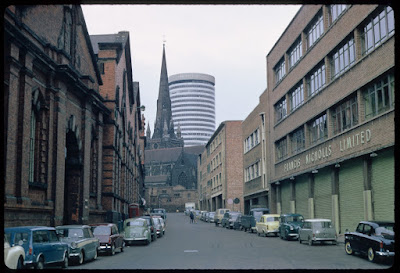
Many of the bus routes from the south of the city decant on Moat Lane by St Martin's church, the perfect stop if you're going to the various markets. The name may seem strange, since Brum isn't the obvious place to find a moat, but of course it refers to the moat of the original manor house of the de Bermingham family, & true to form this has provided me with one of those little puzzles which then fall together nicely.
I love the modern slang use of manor to indicate your patch or area where you hold authority, a use it is given by both police & criminals, & ironically very close to the original meaning of the word. The site of the manor is variously given as on the current wholesale markets site or the Moat Lane car park site. The first picture shows the manor with its moat on the 1731 map of the city (assuming the pictures come out in order). The strange thing was that I couldn't find a picture of the manor anywhere online, & eventually found one in the book referenced below.
The manor was demolished & the moat filled in in 1815, & the then Smithfield market was built on the site. The succeeding pictures are two views of Moat Lane looking increasingly recognisable as today's view, & of a commemorative plaque on the previous fish market. Next comes a scanned newspaper cutting of the cleared site in 1973, in preparation for the building of the wholesale market. I have read that stones were removed from the site to Weoley Castle, which were thought either to be from the manor itself or the retaining wall of the moat, but no archaeological investigation was done. Finally, a picture of the market presently on the site, itself mooted for redevelopment in the near future.
(Picture credits: http://mydigbeth.co.uk/historic-digbeth/
Simon Buteux: Beneath the Bull Ring. Brewin Books, Studley, 2003.)






No comments:
Post a Comment
All comments are moderated before publication